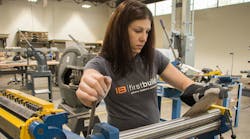Manufacturing technology is ready to embrace the agile microfactory. This concept of a small, highly automated manufacturing space requires a smaller labor force and uses far less energy and materials. Microfactories also are a prime example of the ethos by which the manufacturing industry was born: innovation.
Convincing industries to move from the time-tested Henry Ford methods to smaller production facilities, however, has proven difficult at best. Legacy brands may see “micro” as a job shop — fine for prototypes or one-offs, but incapable of full production in an industry that traditionally sees bigger as better.
But many of the connotations tied to microfactories are out of date. The new contract manufacturer can operate an agile microfactory that’s capable of high-mix, low-volume business with low cost and high ROI. Manufacturers should look at this strategy through the “team of teams” lens — smaller, decentralized groups coming together around a common goal. It’s a mindset that’s proven effective from military operations to corporate boardrooms.
Here are four ways manufacturers can benefit from microfactories.
1. Microfactories offer greater opportunity for rapid innovation
“Microfactory” doesn’t necessarily mean “small manufacturer.” General Electric proved this when it challenged two teams of engineers to design a new helicopter engine; since it’s a small segment of GE’s business, experimentation could be tolerated. The first group used existing methods, and the second was smaller and employed a microfactory strategy. While the first team came back with just one model, the second developed multiple innovative ideas due to the new thinking. Innovations discovered, tested and proven in the microfactory environment can then be integrated into the larger company.
2. Microfactories run on small, agile teams of skilled workers
Labor costs are a concern for any business, but labor availability is an increasing problem for many manufacturers. Nearly 27% of the American manufacturing workforce is poised to retire in the next 10 years, and millennials aren’t necessarily lining up to replace them. It will be important for companies to overcome the public’s perception of these roles as undesirable for the industry to continue to be truly successful. This is a place where microfactories have a huge competitive advantage, offering engineers the opportunity to join an elite, highly skilled team where their expertise and insight will be valued.
Microfactories are able to go small and agile partially thanks to the support of artificial intelligence and robotics. AI analyzes volumes of internal data and provides recommendations, which manufacturing and industrial engineers use to adapt and pivot, programming Industry 4.0 hardware technologies to meet the microfactory’s optimal functionalities, features and workflows. It’s a strong, three-part team—one that can’t exist without talented individuals.
3. Microfactories are ideal for a digital-first world
The evolution of the internet and the cloud has allowed for reorganization and flow of information across multiple locations and time zones instantaneously. When digital communication is built into manufacturing platforms, companies can review data and analytics in real time and pivot based on new information anytime, anywhere. This flow of information makes it even easier and cost effective to adopt microfactories at multiple locations and build the right product for the right customer in the right place at the right time.
4. Microfactories support the market’s demands for mass customization
The nature of demand is changing rapidly. The ability to individually tailor experiences to a specific need or preference quickly at low cost started in the digital world, became commonplace, and now this consumer expectation is transferring over to the physical world. As manufacturing shifts from mass commoditization to dynamic mass customization, factories must demonstrate the ability to adapt production on a moment-by-moment basis in order to compete. This level of customization is also heavily dependent on data and AI at each step, from demand anticipation, to helping customers shape the product via a consumer website, to the real-time manufacturing process.
Highly digitized and automated, with a small footprint allowing them to be located close to the customer, microfactories are right-sized to support mass customization and these “markets of one.” The use of technologies such as additive manufacturing provides the opportunity to quickly adapt products at the digital level and output batch sizes of one without the cost and lead time of previous manual customization methods.
Microfactories are set to emerge as a new form of contract manager: A high-mix environment that still can produce cost-effective manufacturing. With the room to be independent and experiment, microfactories can produce surprising results for manufacturers of all sizes.
Ben Schrauwen is chief technology officer and co-founder of Oqton, a manufacturing AI firm.




